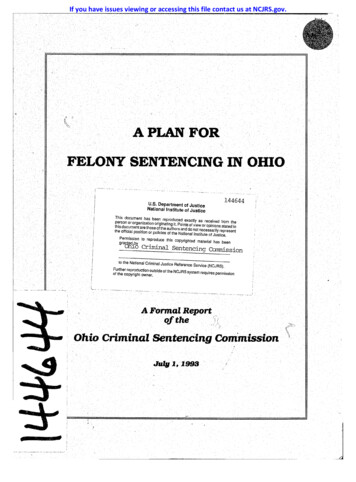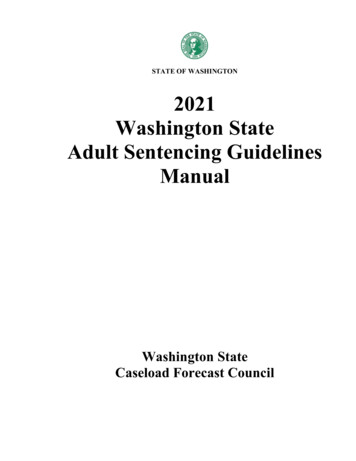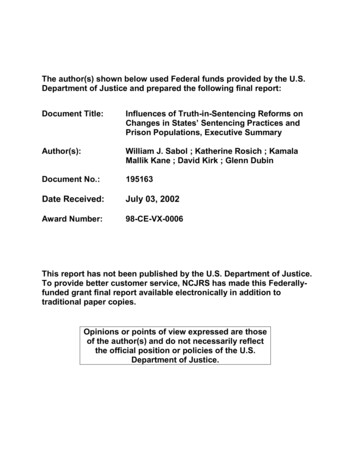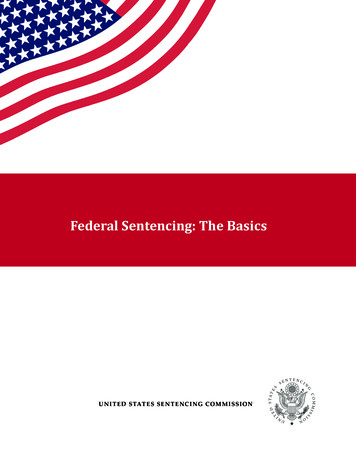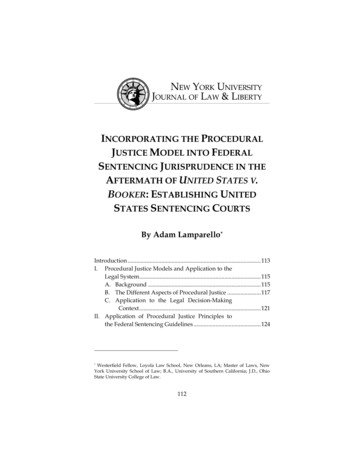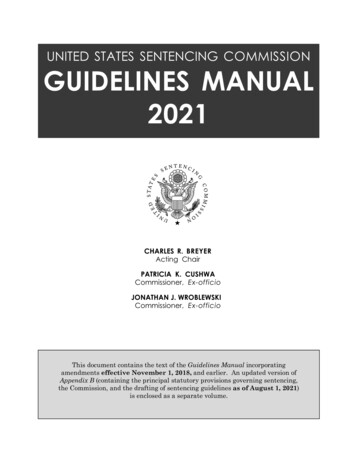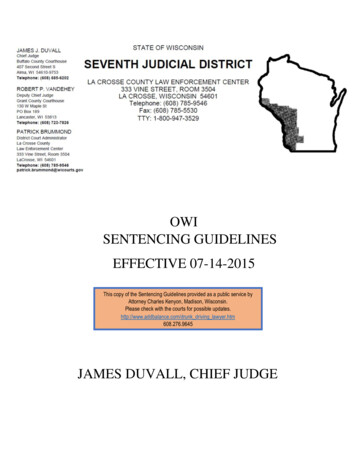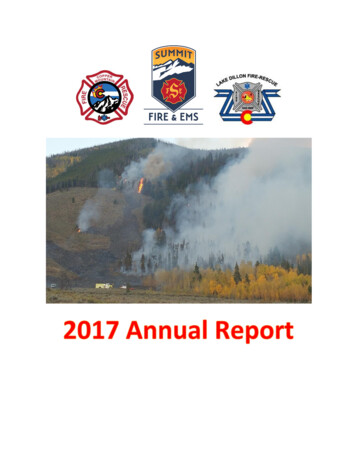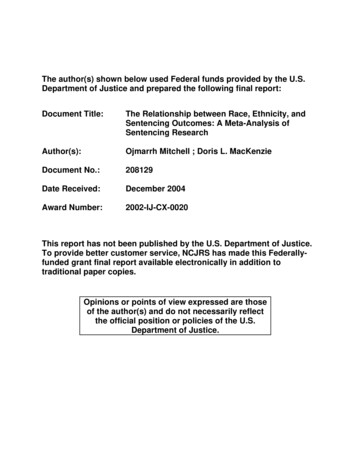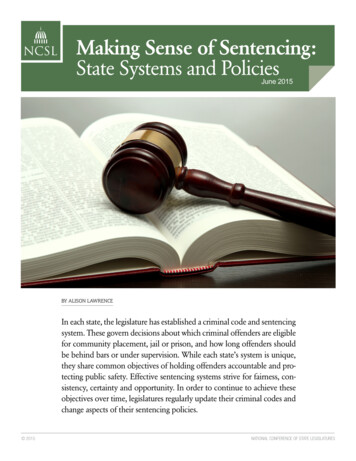
Transcription
Making Sense of Sentencing:State Systems and PoliciesJune 2015BY ALISON LAWRENCEIn each state, the legislature has established a criminal code and sentencingsystem. These govern decisions about which criminal offenders are eligiblefor community placement, jail or prison, and how long offenders shouldbe behind bars or under supervision. While each state’s system is unique,they share common objectives of holding offenders accountable and protecting public safety. Effective sentencing systems strive for fairness, consistency, certainty and opportunity. In order to continue to achieve theseobjectives over time, legislatures regularly update their criminal codes andchange aspects of their sentencing policies. 2015NATIONAL CONFERENCE OF STATE LEGISLATURES
Figure 1: State Felony Theft Threshold AmountsCRIMINAL CODESState criminal codes define what constitutes acrime and the appropriate type and length of pun- 2,500ishment for offenders. Most states classify offens-Wisconsines by severity and assign penalty levels accordingly. Infractions are the lowest class, are generallypunishable by a fine, and often do not involve acriminal conviction. Misdemeanor convictions are 2,000Colorado, Connecticut, Pennsylvania, South Carolinapunishable by a fine or incarceration in local jails,generally no longer than one year. Felonies are themost serious offense class and are usually punishable by more than one year of incarceration ina state-run correctional facility. Offenses also are 1,500Delaware, Georgia, Montana, Rhode Island, Texas, Utahoften sorted by crimes against persons, propertycrimes, drug crimes and other categories. 1,000Arizona, Arkansas, District of Columbia, Idaho, Iowa, Kansas,Maine, Maryland, Michigan, Minnesota, Mississippi,New Hampshire, New York, North Carolina, North Dakota,Ohio, Oregon, South Dakota, West Virginia, WyomingProperty and Drug CrimesThe amount of harm or damage caused is one factor used to determine the severity of an offense.For example, penalties for property offenses typically are based on the value of stolen or damaged 950Californiagoods. States set a monetary amount that qualifies as a felony theft offense, also known as thefelony theft threshold. The majority of states—30 900and the District of Columbia—have thresholds ofVermont 1,000 or greater, 15 have set them at 500 to 950, and five have thresholds below 500. Legislatures have recently revisited thresholds to en- 750sure these amounts keep pace with inflation andAlaska, Indiana, Louisiana, Washingtonthe increase in price of consumer goods. Since2005, at least 26 states and the District of Colum 650bia have increased the felony theft threshold. ThisNevadais an example of lawmakers evaluating and modernizing criminal codes. Raising felony thresholds 500 300Alabama, Illinois, Kentucky, Missouri,*Nebraska, New Mexico, Oklahoma, Tennesseealso complements state reforms designed to focusprison beds on the most serious offenders, ratherthan relatively low-level ones.Figure 1 shows the current felony theft thresholdsFlorida, Hawaiiin states.State laws identify a broad penalty range for each 250offense level and courts then determine sentenc-Massachusettses in individual cases from within these statutoryranges. In recent years, many states have amend 200ed penalty ranges for drug offenses. More than aNew Jersey, Virginiathird of states have amended drug penalty thresholds and levels in the past five years. California,*Missouri threshold will be 750, effective Jan.1, 2017. 2015Source: NCSL, 20142Colorado, Georgia, Kentucky and Utah are amongNATIONAL CONFERENCE OF STATE LEGISLATURES
States Requiring Corrections Impact MEVTGAALLAFLCorrections impact statementsSource: NCSL, 2014DATA-DRIVEN DECISIONSLegislatures are increasingly using datarequiring inmates to serve the final siximpacts and make policy recommenda-to inform decisions about sentencingmonths of a prison term in the commu-tions to the legislature. Courts and cor-laws.nity. A recent study by The Pew Chari-rections agencies also are responsibletable Trusts found that recidivism ratesfor collecting and compiling offender,of inmates released under Kentucky’sprogram and system data.Statistics on who goes to prison andfor how long, recidivism rates, programperformance and operational costs aresome of the data used by legislatures toconsider how policies affect cost, correctional populations and public safety.Colorado lowered penalties for lowlevel drug use and possession in 2010after determining that many offenders convicted of these crimes wouldbe appropriate for community-basednew law were 30 percent lower thanthose released without supervision.States have codified a number of policies on data collection, evaluation andoversight. Legislatures in 18 stateshave adopted laws requiring specialized corrections impact statements forlegislation that would modify criminal offenses and penalties. Legislatures nowA public-private partnership of the Bureau of Justice Assistance in the U.S.Department of Justice and The PewCharitable Trusts’ Public Safety Performance Project has provided morethan half of states with support andassistance on major sentencing andcorrections reforms. Known as “justicereinvestment,” the partnership helpsstates collect data and analyze factorstreatment, rather than prison. The stateoften consider prison population projec-has saved more than 30 million intions and agencies’ use of evidence-prison costs and reallocated much ofbased offender programs to help informthat money to community-based treat-the budget process. Twenty-five statesment services. In Kentucky, betweenand the District of Columbia have30 percent and 50 percent of theestablished sentencing commissionsThese tools and resources help legis-inmate population historically had beento analyze and monitor sentencinglatures ensure that policy choices arereleased without post-prison supervi-practices; many of these commissionsdata-driven and that desired results aresion. In 2011, the state adopted a lawalso conduct research, estimate fiscalsustained. 20153of prison population growth and cost;develop and adopt policies addressingthose factors; and measure the impactof policy changes.NATIONAL CONFERENCE OF STATE LEGISLATURES
states that have made significant changes. TheThese systems vary in the amount of discretionintent in some states has been to differentiate pos-courts or parole boards have for determining of-session offenses from those that involve selling orfenders’ penalties, or “sentences,” and the amountmanufacturing illegal substances. For example,of time they serve in prison, or “time served.”Georgia and Kentucky incorporated the weight ofGenerally, state sentencing systems are charac-the drugs into offense classes so those arrestedterized as “indeterminate” or “determinate.” Mostwith lower drug amounts are penalized less se-states used indeterminate sentencing until the lateverely. Colorado created a separate sentencing1970s, when some began to move toward morescheme for drug offenses that gives courts moredeterminate sentences. Indeterminate sentencesauthority to order treatment or diversion programsare imprecise, while determinate sentences arefor drug offenders and reduces penalties for somefixed. Some states also began to incorporatelow-level drug offenses. California and Utah havestructure into their sentencing systems.shifted many drug possession offenses from thefelony to misdemeanor level. Nineteen states andIndeterminatethe District of Columbia have decriminalized theIn indeterminate systems, legislatures assignpersonal consumption of small amounts of marijuana. These jurisdictions have reclassified theoffenses as infractions or low-level misdemeanorswith no possibility of jail time.broad discretion to decide whether to imposecommunity supervision or a prison term, andthe sentence length that best fits the individualcase and offender. Rationale for indeterminateState-Local Resourcessentencing is a highly individualized penalty thatAmending crime levels can have implications forprovides opportunity for rehabilitation and in-state and local corrections resources. Infractionscludes review of an offender’s progress towardand misdemeanor offenses are processed at thethat objective. A parole board determines whenlocal level while the state becomes responsiblean offender has served sufficient time in prisonfor felony offenders after conviction. Responsibil-and when he or she can safely be released onity for felony offenders sentenced to communityparole. Today, 33 states operate a primarily inde-supervision may rest with local jurisdictions. Toterminate sentencing system.help improve public safety and control prisoncosts, some legislatures have reinvested a por-Determinatetion of state savings from reduced prison popu-Determinate sentencing is characterized by fixedlations into local corrections supervision. Thisincludes “performance incentive” funding structures established to ensure that public safety,reduced recidivism and accountability goals aremet. At least nine states have adopted thesestate-local funding mechanisms, which offer localsupervision agencies incentives to keep offenders in the community rather than send them toprison. To further offset burdens placed on localcorrections agencies, states have limited holds injail pending probation and parole violation hearings and sped up the post-conviction transfer ofinmates from jails to prisons.sentence lengths. Such sentences may be community or prison terms, and prison sentencesgenerally include an additional term of supervision in the community. The amount of time servedis primarily determined by the courts, and paroleboards and discretionary release do not exist indeterminate systems. Rationale for determinatesentencing is to increase certainty in the amountof time served, improve proportionality of the sentence to the gravity of the offense, and reduce disparities that might exist when sentences are moreindeterminate. Today, 17 states and the Districtof Columbia operate a primarily determinate sen-SENTENCING SYSTEMSState sentencing systems guide courts, parole 2015wide sentencing ranges to offenses. Courts havetencing system for felony offenders.Structuredboards and corrections agencies on how to carryWhile states can be characterized as primarilyout punishments authorized in the criminal code.indeterminate or determinate, no state is pure-4NATIONAL CONFERENCE OF STATE LEGISLATURES
Figure 2: States’ Primary Sentencing ALLAMDDCSCARNMIndeterminate GAFLDeterminate SentencingSTStructured SentencingSource: NCSL, 2014ly one or the other. Half of states have added asystems and at the end of a fixed prison term instructured component to their primary sentencingdeterminate systems. The rationale for structuredsystem in order to provide judges guidance, withinsentencing is to enhance fairness and consistencybroad sentencing ranges, on the type and lengthfor similar crimes and categories of offenders.of sentence to order. Structured components aredesigned to increase certainty and consistencyacross jurisdictions for similar offenses and of-Figure 2 shows each state’s primary sentencingsystem and if they have incorporated a structuredfenders.component.Sentencing guidelines are one example of a struc-SENTENCING OPTIONStured component. Created by an administrativesentencing guidelines commission with legisla-Every state has sentencing options other than in-tive authorization, guidelines prescribe penaltiescarceration.based on offense severity and criminal history.Guidelines have been codified in some states, andCommunity Supervisionthey may be advisory or mandatory. PresumptiveState laws allow probation or other communitysentences are another example of structured sentencing. Narrow penalty ranges are set in statutebased on the severity of the offense, and courtsare required to sentence within these ranges unless they find that circumstances warrant a different sentence length.supervision and define eligibility requirements.Courts are given broad authority to order probationfor felony offenses, though the most serious andhabitual offenders are prohibited from receivingthis sanction. Eligibility for other community placements is generally more narrowly defined, suchIn states with a structured component, releaseas for certain low-level or drug-involved offenders.from prison is still determined by the primary sen-States that have incorporated structured sentenc-tencing system—a parole board in indeterminateing often include a directive on whether probation 20155NATIONAL CONFERENCE OF STATE LEGISLATURES
COMMUNITY SENTENCING OPTIONSLevel of Surveillance Typically ProvidedTypeFeaturesDeferredSentenceThe sentence is suspended and is not imposed if the defendantabides by certain court-ordered conditions, such as remainingdrug- and crime-free and paying restitution. Generally involveslittle or no reporting and monitoring nityCorrectionsCentersLevel of Treatment or Services Typically ProvidedA sentence to community supervision, rather than jail or prison,with court-ordered requirements and conditions. Can be combinedwith drug treatment, specialty courts, electronic monitoring orresidential LowMediumHighA probation sentence with increased monitoring and otherconditions, such as daily reporting, substance testing andrestricted activities. Generally paired with treatment programs orelectronic monitoring.LowMediumHighAn electronic device is used to track an offender’s whereaboutsand monitor compliance with conditions, such as curfew andtravel restrictions. Often used in lieu of incarceration andcombined with house arrest or intensive supervision.LowMediumHighLowMediumHighRoutes defendants away from formal criminal processing for aspecified period of time and subject to certain requirements andconditions. Upon successful completion, the conviction will besealed or dismissed. Often paired with drug treatment programsor specialty courts.A specialized court docket that uses increased monitoring,treatment and services to address targeted needs of a defendant.Includes drug courts, mental health courts and veterans’ courts.Can be pre- or post-adjudication and can result in sealing ordismissing a conviction.A structured living environment that provides support services,such as counseling and employment services. Commonly includesresidential or non-residential treatment.Source: NCSL, 2014 20156NATIONAL CONFERENCE OF STATE LEGISLATURES
or other community sentencing should be ordered.Presumptive probation policies direct courts tosentence certain offenders to community supervision instead of prison. In structured sentencingstates, presumptive probation can be establishedthrough sentencing guidelines. For example,Kansas has reduced the incarceration rate ofdrug-involved offenders by requiring communitybased treatment for certain offenders identifiedon a drug-specific sentencing grid. Minnesota hasachieved one of the lowest incarceration rates inthese programs are effective in meeting offenderneeds and reducing crime. Policies providing fordiversionary or deferred sentences allow offenders, usually for first-time, nonviolent offenses, tohave their conviction cleared upon successfullycompleting the program. Record-clearing policiescan remove barriers to employment and restoresome rights and benefits lost as a result of criminal conviction.Risk and Resourcesthe country, in part by incorporating into its sen-Community supervision and diversion policies cantencing guidelines mandatory probation for certainsupport a risk- and resource-sensitive system thatoffenses. In Kentucky and South Dakota—both in-holds offenders accountable, reduces recidivism,determinate states—judges are required to orderand reserves prison space for the most serious of-probation for some low-level felonies unless theyfenders. Strong systems of community supervisionfind that the offender cannot be safely supervisedalso may include allocating resources to supervi-in the community.sion agencies to focus the most intensive supervi-Community supervision is generally ordered asa fixed term for which courts have broad authority, while nearly every state has placed a statutorymaximum on the length of probation. The limit forfelony offenses that are not sex crimes is generally between three and 10 years. At least 18 statession on the most serious offenders. In addition toreforms that reinvest prison savings into programsthat safely and successfully supervise offenders inthe community, states also increasingly are requiring state-funded corrections programs to providedata and evidence that treatment and supervisioncap probation at five years and nine states havestrategies effectively reduce recidivism.limits that vary based on offense or offense class.Sentencing decisions, including who is appropri-Other states limit probation to no more than themaximum time that may be ordered for a sentenceto incarceration. Earned discharge credits, available in at least a dozen states, allow probationersto earn a reduction in their supervision terms byadhering to conditions and rules.ate for certain community supervision programs,are aided today by risk- and needs-assessmentinstruments developed after several decades ofexperience and study. These incorporate actuarial, data-based information related to criminal behavior for people with similar characteristics. ThisDiversionhelps courts determine who is at risk for commit-Diversion policies provide courts with the option tosign an appropriate level of supervision and suit-route defendants away from formal criminal processing and are designed to address offenders’treatment needs. Criminal offenders have highrates of drug abuse, addiction and mental healthdisorders (sometimes co-occurring), and oftenrequire specialized services. Specialty courts, inplace in every state, are a common kind of diversion. These include drug, mental health, veteransor other courts that address the particular needs oftarget populations.ting new crimes, and supervision agencies to asable treatment and services. About one-quarter ofstates instruct sentencing courts to consider theseassessments as part of the sentencing process.In Virginia, an assessment is used to identify andsentence to community supervision low-level drugand property offenders who, under the state’ssentencing guidelines, would otherwise be recommended for a prison sentence. Colorado, Kansas,North Carolina and Oklahoma have laws that limiteligibility for intensive supervision and drug treat-Some states have codified best practices andment programs to moderate- or high-risk offend-require oversight of diversionary treatment pro-ers, as determined by modern risk-assessmentgrams to ensure that, as a sentencing option,tools. 20157NATIONAL CONFERENCE OF STATE LEGISLATURES
Mandatory Penaltiesconviction, sometimes for broad categories of re-Mandatory penalty policies, including mandatoryminimum sentences, are in place in every state.These policies trump a state’s primary sentencingsystem by requiring a minimum sentence lengthor a minimum amount of time or percent of sentence to be served in prison. Mandatory minimumsentence policies may affect broad categories ofcrimes, including repeat offenders and many drugcrimes. Some target the most dangerous, repeatoffenders, often including those who commit violent and sex crimes, offenses committed whilepossessing or using deadly weapons, certain drugcrimes, and crimes involving children, elderly orother vulnerable victims.Many mandatory policies that were adopted in the1990s require offenders to serve a certain portionof their sentence in prison prior to being eligible forrelease. At the time, federal incentives encouragedstate policies requiring that serious, violent offenders serve 85 percent of their sentence in prison. 2015peat offenses. Popular in the 1990s, these include“three strikes and you’re out” laws that require a25-year, life without parole, or other lengthy sentence upon a third conviction.In the years since their enactment, mandatorypenalties have in effect shifted discretion fromsentencing courts to prosecutors. For offenderscharged with and convicted of crimes that have astatutory mandatory penalty, courts must sentencethe defendant in accordance with the law. Prosecutors can choose whether to charge a defendantwith an offense that carries a mandatory term or tooffer a plea bargain to a lesser crime that does notcarry a mandatory sentence.From 1990 to 2009, the average time served inprison grew by 36 percent, according to a report byThe Pew Charitable Trusts. The report found thatmandatory penalties have contributed to the longeraverage prison stays, which cumulatively contribute to increases in state prison populations.Other enhanced penalty policies require increasedRecently, many states have revised some manda-sentence lengths upon a second or subsequenttory penalties, especially for nonviolent and drug8NATIONAL CONFERENCE OF STATE LEGISLATURES
offenses. Since 2000, at least 29 states havestatutes generally specify a minimum amount ofeased mandatory penalties, according to a studytime that must be served before one is eligible forby the Vera Institute of Justice. The study foundparole. The requirement varies from one-quarterthat new laws have given judges greater discre-to half of the total sentence length. In some states,tion to depart from mandatory penalties, limited thean inmate can be considered for parole earliercircumstances under which courts must imposethan the statutory requirement because of sen-mandatory sentences, or narrowed categories oftence credits earned. Parole boards consider timeoffenders subject to the penalties.served, behavior while incarcerated, progress withRELEASE POLICIESindividual case plans, victim input and other factorswhen determining if an inmate should be released.The sentence imposed is only part of the calcula-Some states limit parole boards’ discretion in mak-tion for determining how long an offender spendsing release decisions. For example, presumptivein prison. Sentence credits, parole eligibility andparole policies in Hawaii and New Jersey requireautomatic release policies also affect when an in-release of some inmates at the earliest possiblemate is eligible and suitable for release. Manda-parole eligibility date unless the board finds that re-tory supervision policies ensure offenders receivelease would not be in the interest of public safety.a period of post-prison supervision.Laws in some states also require use of releaseSentence CreditsSentence credits—known as earned time andgood time—are an administrative tool used to encourage and reward good behavior and participation in prison rehabilitative programs. Earned-timecredits are awarded to certain inmates who partici-guidelines to help inform release decisions. SouthDakota and Tennessee have codified guidelinesthat set release eligibility based on offense classand criminal history. Other states, including Colorado and Texas, have adopted such guidelinesadministratively. Texas’ statute instructs the paroleboard to incorporate risk-assessment results in thepate in or complete educational courses, vocation-release decision.al training, treatment, work or other recidivism-re-At least four states with primarily determinate sen-duction programs. Good-time credits are grantedto inmates who follow prison rules and participatein required activities. Earned time can be offered inlieu of or in addition to good-time credits.Forty-one states and the District of Columbia allowmost inmates to earn some time off their prisonterm. In indeterminate systems, sentence creditsgenerally allow inmates to advance their paroleeligibility date. Under determinate systems, timeis reduced from the prison term. State laws varytencing require certain serious, violent or sex offenders to be granted release by a parole board.California, New Mexico and Ohio require offendersconvicted of certain serious crimes or sentencedto life with the possibility of parole to be reviewedby a parole board. Washington has created theIndeterminate Sentence Review Board to reviewparole eligibility of sex offenders.Automatic Releaseconsiderably in the amount of credits that can beUnder determinate sentencing systems, inmatesearned. Credits are prohibited or capped for in-are automatically released or transferred frommates with mandatory penalties. Research hasprison to community supervision at the end of theirfound that sentence credits reduce time servedfixed prison term. In some states, the post-prisonand lower incarceration costs; and participation insupervision term is set by statute as a portion ofrecidivism-reduction programming can improve of-the total sentence. For example, Minnesota lawfender success after release.requires an offender to be released to communityParole EligibilityParole boards are the primary release mechanismin states with predominately indeterminate sentencing. Absent a mandatory minimum sentence, 2015supervision after serving two-thirds of the totalcourt-ordered sentence. Release can be delayed,at the discretion of the corrections department,for violations of prison rules. In other states, thesentencing court is permitted, or required, to order9NATIONAL CONFERENCE OF STATE LEGISLATURES
Figure 3: States with Mandatory Supervision ndatory Supervision (a required periodof post-prison supervision for some or allinmates exiting prison)ALMDNCDCSCARMSGAFLSource: NCSL, 2014a period of community supervision separate frommunity. Improving public safety and reducing re-the prison term. In Illinois, inmates are releasedcidivism are rationales for this policy. Nearly oneto community supervision at the end of the court-in five inmates in 2012 was released with no post-ordered prison term, less the amount of time anprison supervision, according to a report by Theeligible inmate earns from sentence credits.Pew Charitable Trusts. The report indicated thatpolicies that eliminate parole, require minimumMandatory Supervisionlengths of stay, or otherwise increase time-servedTwenty-six states and the District of Columbia require a period of post-prison supervision for someor all exiting inmates, with seven states adoptingrequirements were the primary reasons that offenders were released without supervision.or expanding such a policy in the last five years.INFORMED CHOICESIn a majority of these states, the mandatory post-Legislative decisions about sentencing can haverelease supervision term is ordered by the courtimportant, far-reaching, and often long-lasting ef-and served after the expiration of the prison term.fects on criminal justice systems. Actions designedIn other states, inmates are released to communityto address one identified problem or aspect of thesupervision during the final portion of their sen-system often will have impacts in other areas.tence, usually the last 60 to 180 days.Legislatures today can benefit from data collec-Figure 3 shows states with mandatory supervisionpolicies. 2015VAKYNMTXDEWVTNAZNJOHMOKSRINYWISDWYHIMEVTtion, analysis and technology improvements thatsupport and fulfill information needs. Use of thisinformation by interbranch and intergovernmen-Mandatory post-release supervision provides of-tal councils or task forces can help lawmakersfenders with a formal link to transitional supportgather input from a broad group of stakeholdersservices and allows corrections agencies to moni-and make informed choices on matters of criminaltor offenders during their initial return to the com-sentencing.10NATIONAL CONFERENCE OF STATE LEGISLATURES
REFERENCESColorado Correctional Treatment Board.The Pew Charitable Trusts. Max Out: TheStatutesFY2016 Funding Plan. Denver, Colo.:Rise in Prison Inmates Released WithoutCal. Penal Code §3000Judicial Branch, n.d.Supervision. Washington, D.C.: The PewColo. Rev. Stat. §17-22.5-404, §18-1.3-208Charitable Trusts, June 2014.Haw. Rev. Stat. §706-670Lawrence, Alison. Cutting CorrectionsCosts: Earned Time Policies for StateThe Pew Charitable Trusts. Time Served:Prisoners. Denver, Colo.: NationalThe High Cost, Low Return of LongerConference of State Legislatures, JulyPrison Terms. Washington, D.C.: The Pew2009.Charitable Trusts, June 2012.Subramanian, Ram, and Ruth Delaney.EnactmentsPlaybook for Change? States ConsiderMandatory Sentences. New York, N.Y.:Vera Institute of Justice, February 2014.The Pew Charitable Trusts. MandatoryReentry Supervision: Evaluating the730 Ill. Comp. Stat. Ann. 5/5-8-1Kan. Stat. Ann. §21-6824, §75-5291Ky. Rev. Stat. Ann. §218A.010Minn. Stat. §§244.01, .09N.C. Gen. Stat. §143B-1154N.J. Stat. Ann. §30:4-123.53N.M. Stat. Ann. §31-21-10Calif. Prop. 47 (2014)Colo. HB 1352 (2010)Ga. HB 1176 (2012)Okla. Stat. tit. 22, §988.18Ohio Rev. Code Ann. §2967.13S.D. Codified Laws §22-6-11, §24-15A-32Ky. HB 463 (2011)Tenn. Code Ann. §40-35-501Utah HB 348 (2015)Tex. Gov’t Code Ann. §508.144Kentucky Experience. Washington, D.C.:Va. Ann. Code §17.1-803The Pew Charitable Trusts, June 2014.Wash. Rev. Code §9.95.420RESOURCESNational Conference of Stateinformation available on sentencing andpublic safety, hold offenders accountableLegislatures, Criminal Justice Programcorrections policies that meet both publicand control corrections costs. The projectsafety goals and fiscal objectives.provides expert, nonpartisan usticeNCSL’s Criminal Justice Program is aThe Pew Charitable Trusts,Public Safety Performance Projectanalysis and assistance to states to helpexplore sentencing and corrections reformst
fies as a felony theft offense, also known as the felony theft threshold. The majority of states—30 and the District of Columbia—have thresholds of 1,000 or greater, 15 have set them at 500 to 950, and five have thresholds below 500. Leg-islatures have recently revisited thresholds to en-sure these amounts keep pace with inflation and
